
Victoria Miro, London
22 November 2023 – 13 January 2023
by BETH WILLIAMSON
As contemporary artists and curators work hard to make art and exhibitions more outward-facing, less self-referential, and actively engaging for diverse audiences, it is worth remembering that the British conceptual artist Stephen Willats, who turned 80 this year, has been ploughing that particular furrow for six decades. Participation, communication, social interaction, active spectatorship and self-organisation are at the heart of what Willats does in a multimedia practice that draws on a broad range of fields of inquiry including cybernetics, advertising, artificial intelligence and behavioural theory. It is no surprise to learn that some of the first visitors to this exhibition were sociology students. Willats’ modus operandi is one that sees the artist embedded within the societal structures they reference. This model, which has been referred to as a machine learning system, is one that is both built by and instigates social interaction and has the artist’s community-based projects at its core.
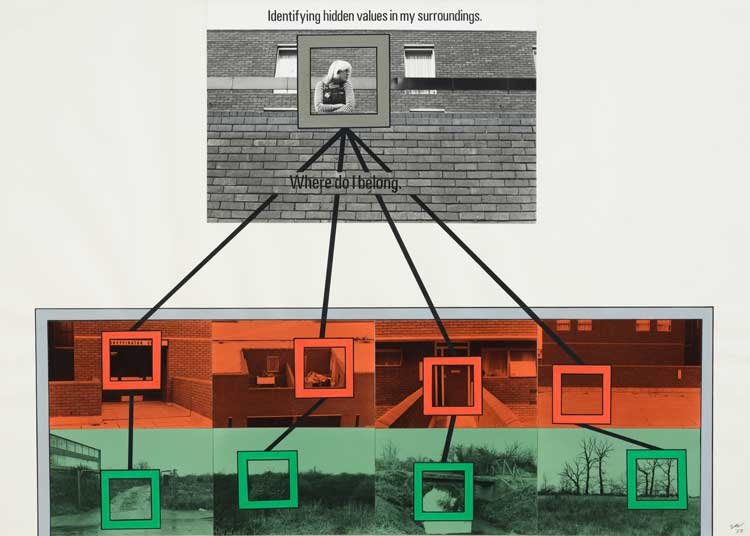
Stephen Willats. Where Do I Belong, 1978. Photographic prints, photographic dye, gouache, ink, Letraset text on paper, 64 x 90 cm (25.22 x 35.46 in). © Stephen Willats. Courtesy the artist and Victoria Miro.
As an exhibition, Time Tumbler presents the chronological extremes of Willats’ career – wall works from the 1970s and recent work made by the artist in the last five years. In the 70s, he devised what he called “neighbourhood projects” in discrete areas of London, Nottingham and Edinburgh. These projects engaged with people in their domestic or work environments, developing over a period of weeks with the intention of uncovering and illuminating the varied and shared stereotypes, perceptions and hopes of their inhabitants. Working closely with the people who populated his chosen environment, Willats used interviews, tape recordings and photography to document these ephemeral projects, documents that then became the building blocks for his, often multipanelled, photographic collages. Ten of these projects, from 1974 to 1980, feature in this exhibition. Often, these works provoke the viewer with prompts that ask them to examine their own perceptions and responses as they move physically and cognitively along the length and breadth of these multipanel works. These images, or groups of images, are constructed from an amalgamation of materials, including photographic prints, gouache, ink and Letraset text, and evoke a linear or sequential model of time.
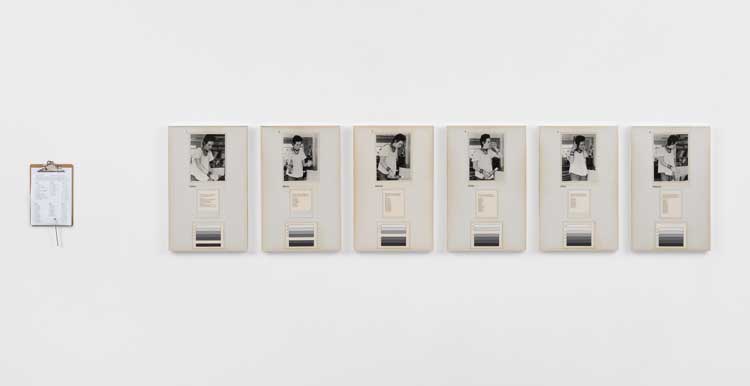
Stephen Willats. A Moment of Action, 1974. Photographic prints, gouache, ink, typed text, Letraset on card, framed with perspex, six panels, each panel 64.5 x 41.3 x 3.5 cm (25 3/8 x 16 1/4 x 1 3/8 in). © Stephen Willats. Courtesy the artist and Victoria Miro.
In A Moment of Action (1974), a woman is shown across six panels in the process of pouring and consuming a drink. Each panel is labelled and viewers are given a list of phrases, or variables, and ask to select the one that best describes the situation. The images are staged and together form a symbolic model of the activity of meeting someone and forming judgments. As co-curator Jelena Kristic understands it, the work “acted as a learning model of pluralism to envision different ways the world could be”.1 In Trying to Forget Where We Came From (1977), interior and exterior worlds vie for our attention. Conscious and counter-conscious narratives are given equal weight, with the viewer left to consider their own interpretation of events.
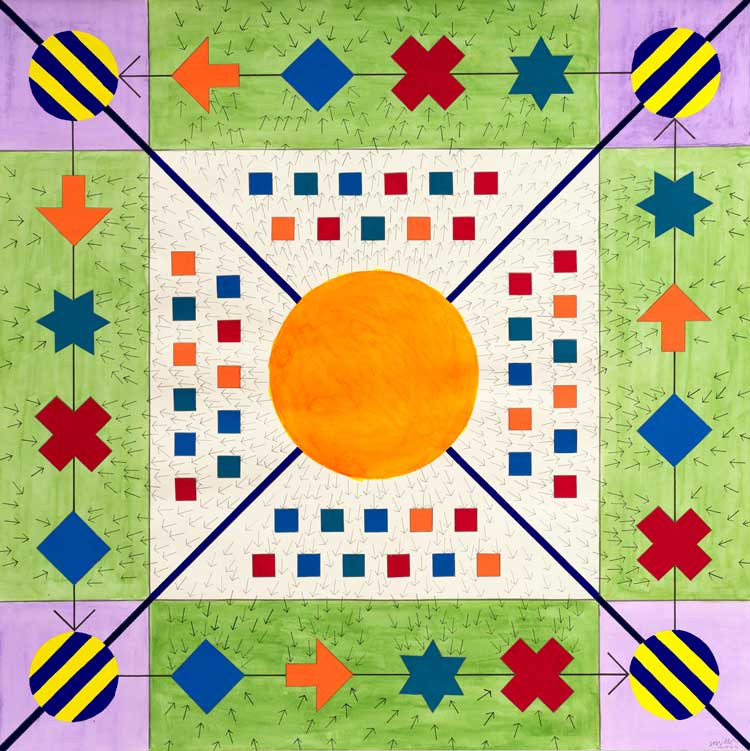
Stephen Willats. Omni Directional Search Engine Drawing No. 9,
2020. Watercolour, pencil, and ink on paper, 100 x 100 cm (39 3/8 x 39 3/8 in). © Stephen Willats. Courtesy the artist and Victoria Miro.
Recent works by Willats develop the ideas he incubated in the 70s. In these newest works, the artist invokes his “time tumbler” model of his longstanding inquiry into how we can alter our perception of reality and make self-determined decisions. The idea of the time tumbler as initially conceived by Willats was further developed in 2020 when he consulted on a project at the British Museum in London. He regarded the museum as a “time box” where objects were trapped (institutionally and architecturally) and cut off from the convolutions of everyday life. Developing a mode of time travel that would allow for speculative navigation of past, present and future, Willats came up with idea of a time tumbler, or time machine, that would free objects from the museum and scramble or reorder fragments of everyday life.
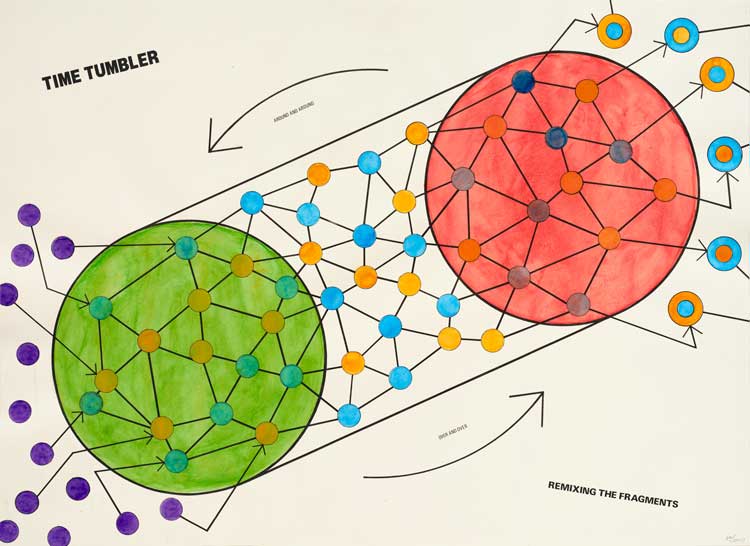
Stephen Willats. Re-mixing the Fragments, 2020. Watercolour, ink, Letraset text on paper, 80 x 110 cm (31 1/2 x 43 1/4 in). © Stephen Willats. Courtesy the artist and Victoria Miro.
Although his time machine has never been realised, his drawings and ideas appear in the diagrammatic works such as Remixing the Fragments (2020) and Passing Through the Time Tumbler (2022). Here, time is no longer linear. Instead, works are now omnidirectional and gesture to a sense of the infinite, something that is reflected in the bright multicoloured palette the artist uses in these diagrammatic works, sometimes including the entire colour spectrum in a single image. There is a real sense of continuous movement in the Omni Directional Search Engine Drawings as massed arrows form multiple flow patterns between and around boldly coloured geometric shapes. These are all arranged within, or around, a circular motif of one sort or another so that flows also tend to generate a strong sense of circular movement, movement that might suck us in with its vortex-like pull, or, alternatively, expel us with its force.
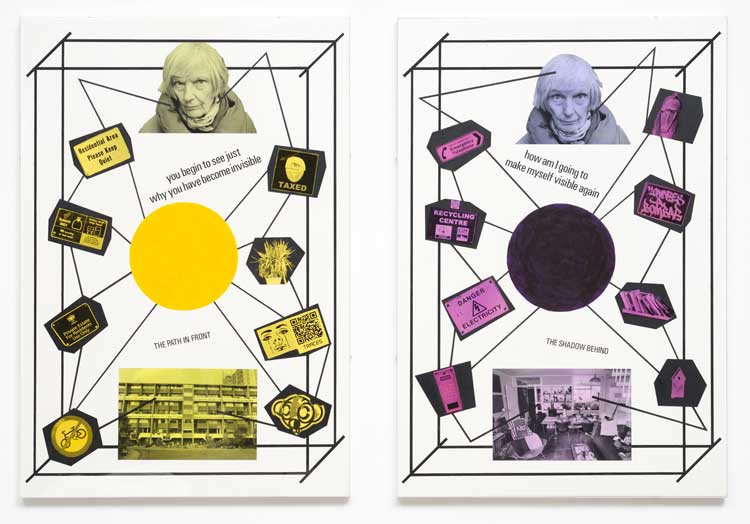
Stephen Willats. The Path In Front and The Shadow Behind, 2022. Photographic prints, photographic dye, acrylic paint, Letraset text on card, framed with perspex, two panels, each panel 105 x 72 cm (41.3 x 28.3 in). © Stephen Willats. Courtesy the artist and Victoria Miro.
Other recent works such as Inside the Time Box (2023) and The Path in Front and The Shadow Behind (2022), despite their bold use of colour, are visually much closer to the works of the 70s. Kristic’s summation is: “Willats’ re-creation of this earlier visual language in his recent ruminations on time aptly instantiates the remaking of oneself summoned by the time tumbler and the interrelated and metamorphosing forms of his practice over the past 65 years.”2 Of course, in the two examples mentioned, the focus is on the place and plight of a single subject in society rather than the community context he commonly addressed in those early works. In essence, Willats’ work represents a social state or condition, as well as the vicissitudes of the social relationships therein. What is surprising, perhaps, is that his clean graphic and conceptual approach belies the sudden moments of empathy that arise in this exhibition. Yet, it is the human condition that is at the heart of Willats’ work, how we communicate, how social structures impinge on our lives, how we see ourselves and others, and how we navigate our everyday lives. Once you realise that, empathy is not so surprising after all.
References
1. Jelena Kristic. In Stephen Willats: Time Tumbler by Bronaċ Ferran, John Kelsey, Jelena Kristic and Stephanie Willats, published by Victoria Miro, 2023, page 55.
2. Ibid, page 68.
From river pollution to radioactive waste, through aquatic atmospheres and mythic journeys, Emilija ...
This magnificent exhibition includes bold posters, woodcuts, portraits and still lifes, but it is Wi...
Through painting, sculpture and film, three international artists ask us to reflect on ecological de...
Dana Awartani: Standing by the Ruins
Using traditional craft techniques, Dana Awartani traces the destruction of cultural heritage sites ...
The loss of an icon is ever of great note but that the iconoclast architect Frank Gehry’s passing ...
Luigi Ghirri: Polaroid ’79-’83
Luigi Ghirri’s spell using Polaroid cameras takes us on an imaginary adventure, with leading clues...
A groundbreaking exhibition turns the way we think about sculpture on its head. Every object has its...
Photographer Merlin Daleman talks about how his new photo book, Mutiny, captures the backstory of th...
Three seductive, spellbinding films demonstrate the Uzbek artist and film-maker Saodat Ismailova’s...
German painter Gerhard Richter enchants, astonishes and unnerves in this compendious retrospective, ...
Karimah Ashadu’s three films may aim to give a voice to marginalised men in the former British col...
Playing with Fire: Edmund de Waal and Axel Salto
The artist and author Edmund de Waal has curated the first major exhibition of the Danish ceramicist...
Women of Influence: The Pattle Sisters
Seven sisters made their mark on Victorian art and culture and deserve to be far more than just dist...
Anindita Dutta: The Shadows of Duality
Shifting from her usual clay to recycled shoes, animal hides, fur, fabrics and more, Anindita Dutta ...
Berthe Weill: Art Dealer of the Parisian Avant-garde
This milestone exhibition celebrates the pioneering art dealer Berthe Weill, who launched the career...
Artes Visuales: The Latin American Avant-Garde in Print
Focusing on the influential Artes Visuales magazine and the extraordinary experimental artists it fe...
Rae-Yen Song 宋瑞渊, •~TUA~• 大眼 •~MAK~•
This is a theatrical space like no other in which, using sculpture, sound, textiles and performance,...
Celebrating the photographic work of Lee Miller in grand style, this retrospective showcases her man...
Now in her 70s, and with a show at the Irish Museum of Modern Art in Dublin, Cecilia Vicuña’s act...
Jaune Quick-to-See Smith: Wilding
This posthumous exhibition of Jaune Quick-to-See Smith’s art includes work made right up to her de...
Ayoung Kim: Delivery Dancer Codex
A trilogy of video works featuring two queer, female delivery drivers in Seoul, Ayoung Kim’s Deliv...
The Tate’s landmark exhibition presents a fascinating story, but could have done more to capture t...
Known as a gallerist to the likes of Rauschenberg and Rothko, Betty Parsons spent her weekends makin...
In a powerful new show of painting, sculpture and film, the artist brings folkloric traditions and m...
Robert MacBryde and Robert Colquhoun: Artists, Lovers, Outsiders
The two men from working-class Scottish backgrounds met at art school and became inseparable. This e...
Push the Limits: Culture Strips to Reveal War
A diverse group of works in this exhibition at Fondazione Merz show how contemporary art responds to...
Artes Mundi 11 Prize and Exhibition
Against a background of divisive global politics and hysteria around migration, the six artists shor...
At Aberystwyth Arts Centre, Anawana Haloba has staged an “experimental opera”, as she terms this...
Jumana Emil Abboud – interview
Drawing on folklore, mythmaking and storytelling, Jumana Emil Abboud articulates the strains placed ...
Rhiannon Hiles, chief executive, Beamish Museum – interview
Winner of the world’s largest museum prize, the £120,000 Art Fund Museum of the Year, Beamish, an...